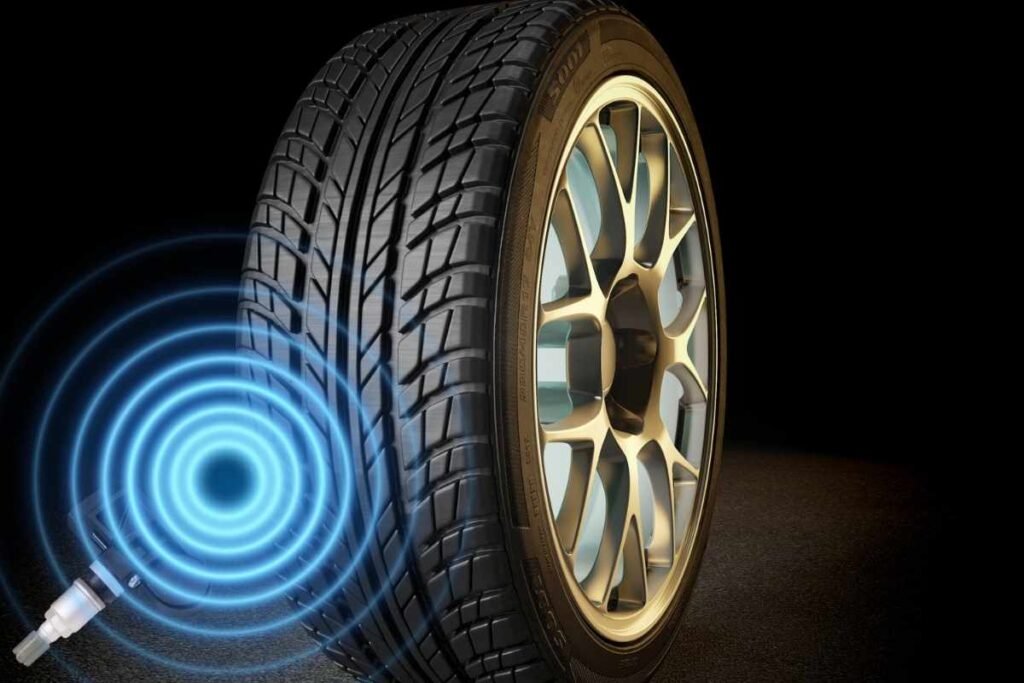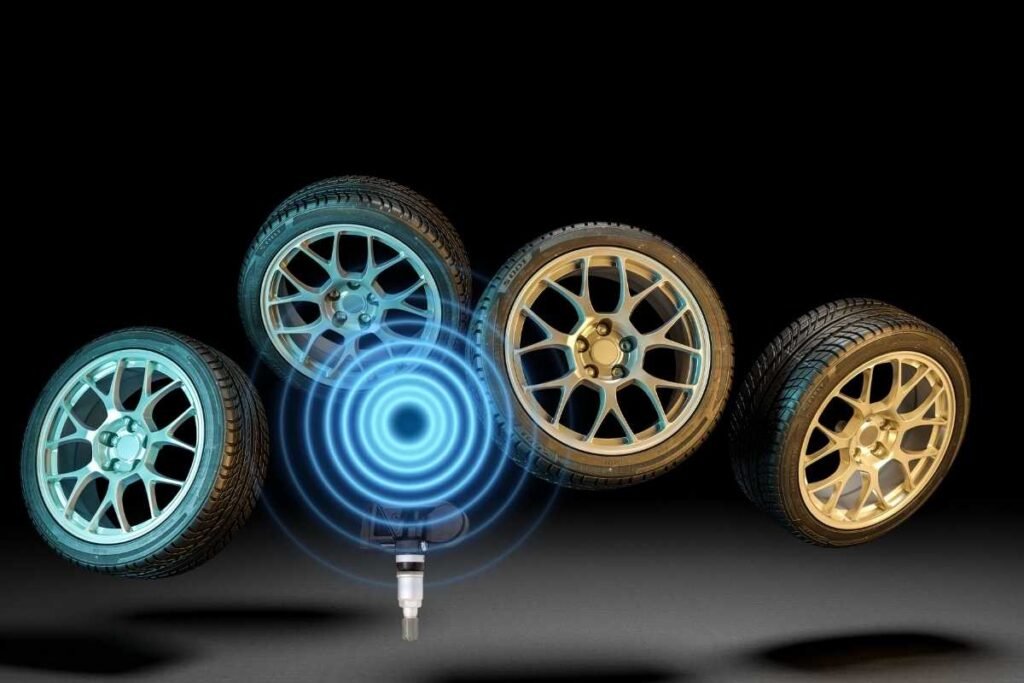How To Find A Cars TPMS Frequency? 2 Individual Ways (OBD II and VIN)
A few years back, I was figuring out the TPMS frequency for my Toyota RAV4 Limited felt like solving a riddle. Online guides were completely vague and incomplete. So, I tried some tricks I learned earlier from my father turned on the ignition without starting the engine and used a TPMS diagnostic tool.
After some trial and error, it finally picked up each tire’s frequency. But the errors are annoying and time consuming, and I will explain the process here. Well, the Tire Pressure Monitoring System (TPMS) sensors use radio frequency technology to send information about tire pressure and temperature.
Most TPMS sensors operate at either 315MHz or 433MHz frequencies. The sensors keep your tires performing well by alerting you if there’s a significant change in pressure.
Other electronic devices can sometimes interfere with the sensors, leading to inaccurate readings. To avoid this and secure your vehicle, regular monitoring and correct placement of the sensors are important.
You need to know the basics of TPMS frequency so that they can make the proper response whenever required. Yet, you don’t need to be a professional or expert; only learning some primary things would help immensely in emergencies!
What Is TPMS Frequency?
TPMS frequency refers to how often the Tire Pressure Monitoring System (TPMS) in a vehicle checks each tire’s pressure. Since the frequency varies by car model and manufacturer, TPMS systems generally check tire pressure every few seconds or minutes.
The continuous monitoring alerts drivers promptly if a tire is underinflated, helping to prevent accidents, extend tire life, and improve fuel efficiency. Some advanced TPMS systems can detect other issues, like sudden pressure loss, offering an extra layer of safety.
TPMS sensors most commonly operate at either 315 MHz or 433 MHz, depending on the region and vehicle model, as these frequencies are less prone to interference.
The sensors send real-time data to the vehicle’s onboard computer, providing precise and timely alerts to help maintain optimal tire performance.

TPMS Frequency Chart for Popular Cars
Different car brands and models may use specific frequencies for their TPMS sensors. Particularly it helps to optimize the performance and reduce interference with other wireless systems.
The frequencies, usually 315 MHz or 433 MHz, are designed to comply with regional regulations and ensure reliable data transmission.
Here’s a general TPMS frequency chart for some of the most popular car brands. These frequencies can vary by model and year, so it’s always recommended to check the vehicle’s manual or consult a dealer for precise information.
| Vehicle Manufacturer | Model(s) | TPMS Frequency (MHz) | TPMS Type | Notes |
|---|---|---|---|---|
| Acura | MDX, RDX, TSX, ILX | 315 | Direct | Most models from 2008 onwards use 315 MHz sensors. |
| Audi | A3, A4, A5, Q5, Q7, TT | 433 | Direct | Vehicles typically from 2008 onwards. |
| BMW | 1 Series, 3 Series, 5 Series, X Series | 433 | Direct | Most models after 2007. |
| Chevrolet | Malibu, Impala, Silverado, Equinox | 315 | Direct | Models from 2007 onwards generally use 315 MHz sensors. |
| Chrysler | 300, Pacifica, Town & Country | 315 | Direct | Primarily 2007 and newer models. |
| Dodge | Charger, Challenger, Durango, Ram | 315 | Direct | Most models from 2007 onwards. |
| Ford | F-150, Mustang, Explorer, Escape | 315 | Direct | Common in models from 2007 onwards. |
| Honda | Accord, Civic, CR-V, Pilot | 315 | Direct | Typically used from 2008 onwards. |
| Hyundai | Elantra, Sonata, Santa Fe, Tucson | 433 | Direct | Models from 2008 and newer. |
| Infiniti | G Series, Q50, Q60, QX Series | 433 | Direct | Most models from 2008 onwards. |
| Kia | Optima, Sorento, Sportage | 433 | Direct | Models typically from 2008 onwards. |
| Lexus | RX, ES, NX, GS, LS | 433 | Direct | Generally used in models from 2008 and up. |
| Mazda | Mazda3, Mazda6, CX-5, CX-9 | 433 | Direct | Mostly from 2007 onwards. |
| Mercedes-Benz | C-Class, E-Class, S-Class, GLE, GLC | 433 | Direct | Most models post-2008 typically use 433 MHz. |
| Nissan | Altima, Sentra, Rogue, Pathfinder | 433 | Direct | Common in models from 2008 onwards. |
| Subaru | Outback, Forester, Legacy | 433 | Direct | Most models use 433 MHz sensors from 2008 onwards. |
| Toyota | Camry, Corolla, RAV4, Tacoma | 433 | Direct | Generally found in vehicles from 2006 onwards. |
| Volkswagen | Jetta, Passat, Golf, Tiguan | 433 | Direct | Commonly used in models from 2008 and newer. |
| Volvo | XC90, S60, S80, V60, V70 | 433 | Direct | Most models from 2008 and later use 433 MHz sensors. |
I’ve shared some data with you to give you an idea, but please double-check the specific frequency based on your vehicle’s model and year to make sure it’s accurate.
How To Find A Cars TPMS Frequency?: 2 Individual Methods
To find my car’s TPMS frequency, I went through my vehicle’s owner’s manual, which contains detailed information about the TPMS system.
Look for sections like “Tire Pressure Monitoring” for guidance on how the system works and its check intervals. Additionally, check your dashboard for a TPMS indicator light that alerts you to low tire pressure.
Method 1: How To Find A Cars TPMS Frequency With OBD-II Scanner in 5-Steps
In this method, I used an OBD-II scanner to retrieve information on your TPMS system for more detailed data. If you see the process hard, contact the vehicle manufacturer for specific details.
Here are the options I found, check them below…

1. Reading Manual:
Your owner’s manual is your vehicle’s primary information source. It contains detailed specifications and instructions for all its systems, including TPMS.
Look for sections titled “TPMS,” “Tire Pressure Monitoring,” or something similar. The manual should provide information about your car’s type of TPMS system and how often it checks tire pressure.
2. Checking Dashboard:
Many modern vehicles have a TPMS indicator light or display on the dashboard. This light usually illuminates when the system detects a low tire pressure.
The owner’s manual will explain the specific meaning of the TPMS light or display on your car’s dashboard. It may also provide information about the frequency of checks.
3. Using OBD-II:
If your car has an onboard diagnostics or OBD-II port, you can use a diagnostic tool to retrieve TPMS information.
OBD-II scanners can provide details about TPMS sensor status, tire pressure readings, and potentially the frequency of checks.
4. Contacting Manufacturer:
If you can’t find the information in your owner’s manual or through OBD-II, contact the manufacturer’s customer service.
They can provide specific details about your car’s TPMS system, including the frequency of checks.
5. Research Online:
Automotive forums and online communities often have discussions about TPMS systems. You might find information about specific car models or general trends regarding TPMS frequency.
Carefully always verify any information you find online with the manufacturer or a trusted source.
Method 2: How To Check TPMS Frequency by VIN Number?
The VIN is a unique identifier for your vehicle, and it can be used to access detailed information about its systems, including TPMS.
Finding the TPMS frequency using your Vehicle Identification Number (VIN) can be an easy and quick step in maintaining your vehicle’s safety and performance.
Here’s a simple process to check the TPMS frequency:

1. Finding the VIN
The VIN is a unique 17-character code that serves as your vehicle’s fingerprint, providing important information about its make, model, year, and more.
- On the Dashboard: Look at the lower corner of the driver’s side of the dashboard, near the windshield. The VIN is often visible through the glass.
- Driver’s Side Door Jamb: Open the driver’s side door and look for a sticker or metal plate on the door frame. The VIN is usually printed there.
- Vehicle Registration Documents: Your VIN can also be found on your vehicle’s registration, insurance documents, and title.
2. Using VIN Lookup:
Once you have your VIN, the next step is to utilize online VIN decoding tools to extract detailed information about your vehicle. There are some reliable websites dedicated to decoding VINs, which can provide insights into your vehicle’s specifications, including the TPMS frequency.
Check these VIN decoders:
- NHTSA VIN Lookup: The National Highway Traffic Safety Administration (NHTSA) provides an official VIN decoder that can give you access to detailed vehicle information.
- VINCheck.info: VINCheck is a free VIN lookup that can provide the required details about your vehicle, including possible recalls and specifications.
3. Contacting Customer Service:
If the online tools do not yield the specific TPMS frequency you’re looking for, you can directly contact your vehicle’s dealership.
Dealerships have direct access to the manufacturer’s database and can provide accurate information regarding your vehicle’s specifications.
When you call or visit the dealership, be prepared to:
- Provide Your VIN: Clearly give your VIN to the service representative. They will use this information to look up your vehicle in their system.
- Ask for Specifics: Inquire directly about the TPMS frequency, and if they can provide any additional details regarding the TPMS system in your vehicle.
Moreover, this method is highly reliable, as dealerships have up-to-date information on all vehicles they sell.
How To Change TPMS Frequency in 3-Steps
Changing the TPMS frequency is more about resetting or reprogramming the system rather than altering the frequency itself, as the frequency is predetermined by the sensors.
The TPMS frequency is generally not a user-adjustable setting, as it involves the system’s radio frequency. However, there are ways to adjust or recalibrate the system if you switch TPMS sensors or troubleshoot frequency-related issues.
Here’s how you can approach it:
Step 1. Use a TPMS Diagnostic Tool
Start by locating the OBD-II port, which is usually situated under the dashboard on the driver’s side. With the ignition turned to the “on” position (but the engine off), plug in the TPMS tool.
The device will start up, and you’ll need to explore its menus. Keep an eye out for options that say ‘TPMS reset’ or ‘programming’.
The tool will lead you through the magical steps to talk to your car’s TPMS sensors.
Step 2. Reset or Reprogram the TPMS
Once the diagnostic tool is all set up and ready, just follow the on-screen instructions to start the reset or reprogramming process. It usually means scanning each tire sensor one by one to make sure they’re talking to the car’s system properly.
As you work through the tool’s prompts, it might ask you to double-check the names of each sensor. So, take your time and make sure you get it right!
After the programming is complete, the tool will usually provide a confirmation message indicating that the reset was successful.
Take a moment to review the results on the tool’s display, ensuring that all sensors are registered and functioning correctly.
Step 3. Test the System
After the reset or reprogramming, it’s time to give the system a thorough test to make sure everything’s in tip-top shape.
Turn off the ignition and then start the engine. Let the vehicle run for a few minutes and keep a close eye on the dashboard for any TPMS warning lights.
If the warning light stays on, it might mean there’s a problem with one or more of the sensors or that the reset didn’t work.
To double-check, use a tire pressure gauge to check the pressure in each tire. The TPMS should show the correct tire pressures.
If you keep having issues, it might be a good idea to call in a professional mechanic who can help you figure out what’s wrong and get things fixed.

What is the Difference Between 315mHz and 433mHz TPMS?
The 315 MHz sensors are mostly used in cars made for North America, including many American brands and some models from Japanese and European makers.
On the other hand, the 433 MHz sensors are more common in cars made for Europe and some Asian models. This isn’t just a matter of preference; using the wrong frequency can cause serious problems with the TPMS.
For example, if a car needs 315 MHz sensors, but it has 433 MHz sensors, the TPMS won’t be able to read the tire pressure. This means the alerts won’t be accurate and there could be safety risks.
Operating Frequency
The 315 MHz TPMS sensors are mostly found in North America, especially in cars made by American, Japanese, and some European companies. On the other hand, 433 MHz sensors are more common in European cars and certain Asian models.
Compatibility
It’s super important to make sure your vehicle is compatible. Cars made for North America usually need 315 MHz sensors, while those in Europe use 433 MHz.
If you use the wrong frequency, your car won’t be able to talk to the sensors, and you won’t get accurate tire pressure readings. That could be dangerous, so you need to get the right kind of sensors for your car.
Sensor Design and Features
Both sensor sensors do the same thing, but they might use different ways to talk to each other and have different features.
These differences can affect how well they work, and while there might be a tiny difference in how far they can go or how long their batteries last, it usually doesn’t make one frequency better than the other.
Market Availability
The availability of 315 MHz sensors and accessories can differ depending on where you are. North America has a wider selection of these options compared to 433 MHz, which might be more limited in other parts of the world.
Legal and Regulatory Factors
Different regions have their own rules about how often TPMS sensors should send signals. In the U.S., the FCC sets the rules for the 315 MHz frequency, while in Europe, they have different rules for the 433 MHz frequency.
If you want to make sure you’re getting the right sensors for your car, it’s important to know these rules.
FAQs
How do I find out the TPMS frequency of my car?
You can find your vehicle’s TPMS frequency in the owner’s manual, as it is often explicitly stated. You can also check on the TPMS sensor itself, as it usually has the frequency (315 MHz or 433 MHz) stamped right on it.
The frequency and ID of the sensor can also be read with a TPMS diagnostic tool. Or you may also contact your vehicle dealer and provide the Vehicle Identification Number (VIN) to obtain the TPMS frequency.
Do all vehicles use the same TPMS frequency?
No, not all vehicles use the same TPMS frequency. Cars have different TPMS frequencies, usually 315 MHz or 433 MHz. It does depend on the make, model, and year of the vehicle.
Can you use a 433 MHz TPMS sensor on a vehicle that requires a 315 MHz sensor?
No, a TPMS sensor with the wrong frequency will cause the relearn to fail and/or the sensor program to fail. It is very critical to ensure the sensor frequency is compatible with your vehicle’s needs.
Is there any universal TPMS sensor that works with both 315 MHz and 433 MHz frequencies?
Some aftermarket TPMS sensors, such as Alligator dual-band or Schrader EZ-sensor, can be programmed to operate at either 315 MHz or 433 MHz. Proper programming and configuration, however, must be performed for it to be compatible with your vehicle.
If you install the wrong frequency TPMS Sensor what will happen?
Installing a TPMS sensor with the wrong frequency will not allow the system to communicate properly, which will result in a failed relearn procedure and/or failed sensor programming. This will keep the TPMS warning light ON, and the system may not function properly.
Can a TPMS diagnostic tool determine the sensor’s frequency?
Yes, most TPMS diagnostic tools can detect the sensor’s frequency. TPMS diagnostic tools can read or activate the sensor and display the frequency information. This assists technicians in identifying the proper sensor frequency for the vehicle make, model, and year.
Where is the TPMS sensor on my car?
The direct TPMS sensors are usually mounted inside a tire, attached either to the valve stem or to the wheel rim. These sensors read the air pressure inside the tire and transmit this information to the onboard computer.
How long do TPMS sensors last?
TPMS sensors are battery-powered, and they’re supposed to last around five to ten years. When the battery dies, typically, the entire sensor needs to be replaced.
You have to reprogram the TPMS sensors when you rotate your tires. Tire rotation may require reprogramming or relearning the sensor positions in vehicles equipped with direct TPMS systems so the system identifies each tire’s location accurately. This process varies by vehicle make and model.
Can I turn off the TPMS system in my car?
Do not disable the TPMS system; it is a very important safety feature. It will alert you in case of under-inflated tires. It is also illegal in many places to disable or tamper with the TPMS system.






